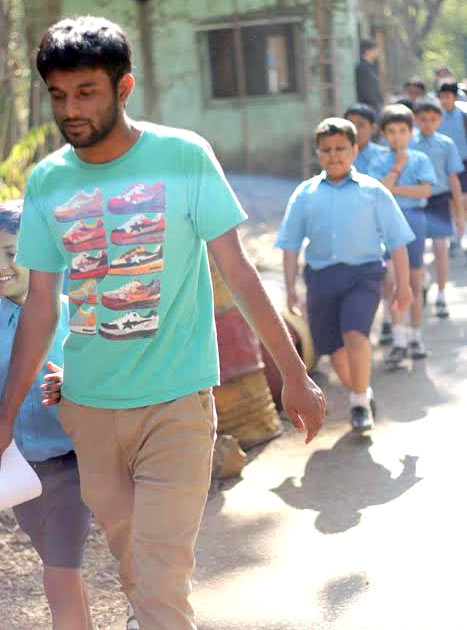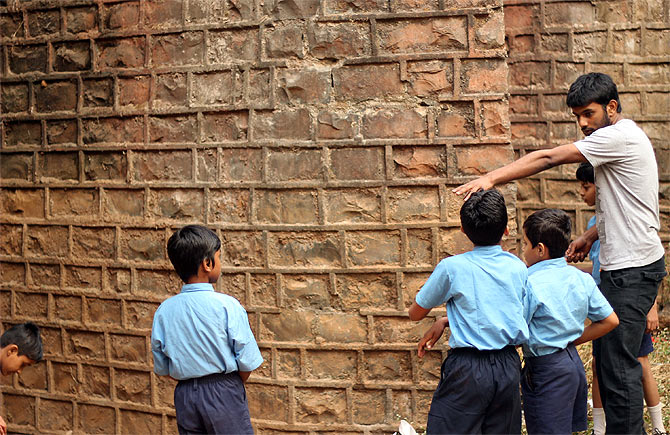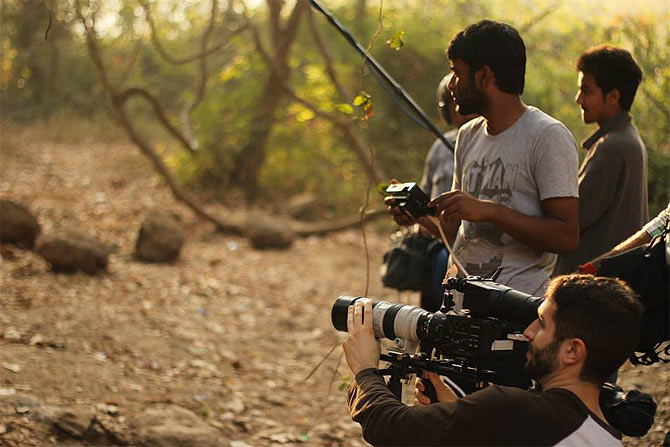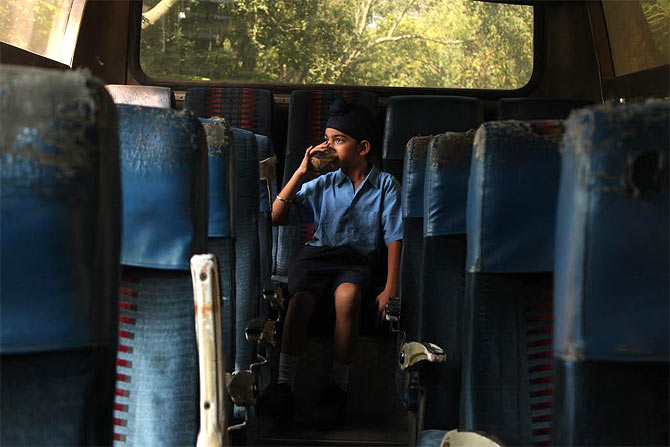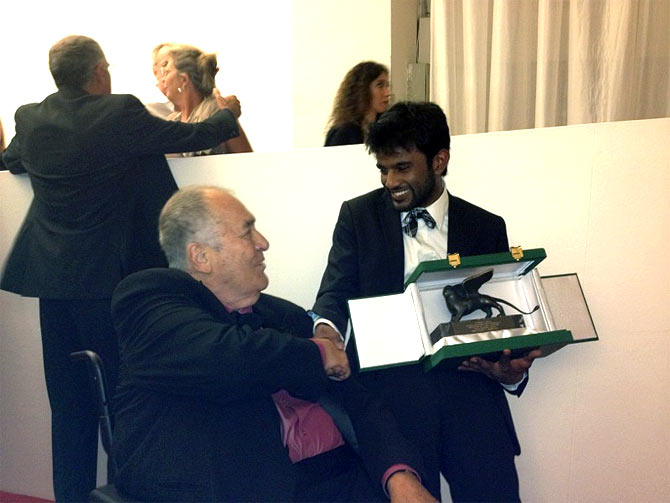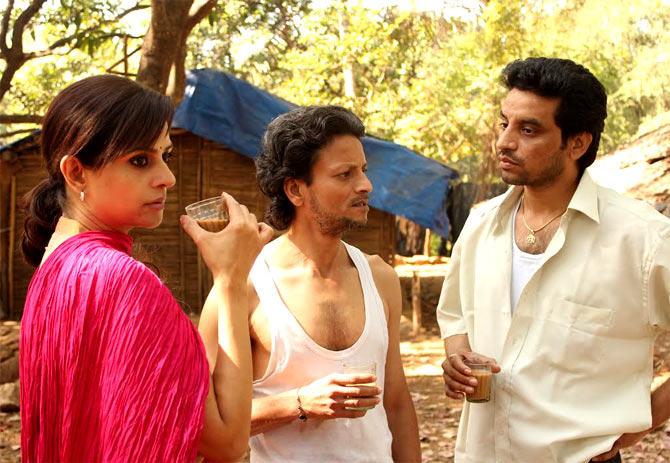Shubhashish Bhutiani: The making of a filmmaker
December 25, 2013 14:01 IST
Shubhashish Bhutiani shares the incredible journey of his debut film -- from the imagination of a freshly minted graduate to the Oscars shortlist -- with Aseem Chhabra.
At 22, most young men and women barely have a sense of where they are headed with their personal and work life. But Shubhashish Bhutiani knows exactly where he may be going.
Right now there is a strong possibility that his 20-minute film Kush may make it to the five nominated films in the Best Live Action Short Film category for the 2014 Academy Awards.
It is a remarkable achievement for Bhutiani who graduated from New York City’s School of Visual Arts in May with an undergraduate degree in directing and writing.
Earlier this fall, Kush premiered at the Venice Film Festival, where it won the Orizzonti award for Best Short Film. Since then the film has played at the number of festivals, including the South Asian International Film Festival in New York City, which concluded December 8.
Kush is set around the time of Indira Gandhi’s assassination and the aftermath of the anti-Sikh riots in Delhi and other parts of India.
A school bus returning from a picnic is stopped by a group of hoodlums looking for Sikhs. The gripping story narrates how a schoolteacher and the children hide a Sikh classmate from the mob and the police.
The film boasts of wonderful performances by the young children -- most of them non-actors.
Bhutiani spoke to Aseem Chhabra while he was in Brescia, Italy, attending the Brescia Film Lab Festival.
Congratulations! How does it feel?
I don’t know how to answer that question, because it’s like stuff we dream of. There are many new feelings.
Tell me about the film festival in Brescia.
It’s a small festival in Brescia that is one hour away from Milan. I like the panel of films they have shown. They showed the short film that won the Oscar last year -- The Curfew. Last year they had the Afghan film nominated for the short film Oscar, Buzkashi Boys. I wanted to be a part of the group and meet the other filmmakers.
Click Next to read more
'The story of a school bus became a vehicle to tell the larger story'
December 25, 2013 14:01 IST
You just graduated from SVA. I wonder how many SVA students go this far, going to Venice and then shortlisted for the Oscars.
In my time I haven’t heard of anyone. So it’s amazing.
After you finished Kush, did you just send the film to major festivals?
We were looking at festivals that were happening after June, because that’s when I completely finished and we wanted a competitive festival. Venice was coming up. The problem was that they wanted 20 minutes and our film is 25 minutes. So I spent the next month cutting it down.
It was kind of shooting in the dark, but I had a feeling this film had the potential to do well.
I genuinely mean that, because of the children and their performances. I increasingly felt better about it as more people watched it.
That’s what I wanted to ask you. It is such a foreign story to non-Indians. You make a statement in the end about how many people were killed during the anti-Sikh riots. When you first showed it to your American colleagues or your professors at SVA, how did they react? Did you have to explain much to them?
Everybody loved the film. Loved may not be the right word in this context, but they felt connected to the film. The only debate I had was how much information was enough. About how violent is everything? Do we need to know the background of the story before we start?
I felt that since we were watching the film through the children’s eyes, we didn’t need to know much about the background, because they don’t understand what’s going on.
So you kind of grow with the story, with the characters. In the end I was in two minds about how much to say.
If you trying to tell a true story, then you have to give a real idea about what went on. You owe it to the people. I think that is integral to the film.
I read that you had heard the story when you were attending Woodstock School, and that this incident actually happened on a school bus.
The real story is much bigger. It was about older children who were 15 or 16 and were coming back from Rajasthan to Mussoorie.
I liked the idea of it, the metaphor behind it and the microcosm that existed.
I read a lot of books and newspaper articles. This story of a school bus became a vehicle to tell the larger story, to talk about the event. So I wanted to incorporate other people’s experiences as well, not just this one Sikh boy’s.
'I always wanted to make something in India'
December 25, 2013 14:01 IST
When did you write the script?
I wrote it for the first time in May 2012, but I wanted to make it since the day I heard the story.
Was it a part of the school project?
We had to come up with an idea for our last project in school. I always wanted to make something in India, something I really personally cared about, because I also knew it would take a year-and-a-half of my life.
Where did you shoot?
We shot outside Bombay in the Ghats. In an ideal world I would have loved to shoot it outside Mussoorie, but we had logistical restrictions. The film still looks amazing. My cinematographer Mike McSweeney (SVA graduate in 2012) did a great job.
How did you cast the kids?
The casting is one of my favourite parts of the story, because I think it explains a lot about the spirit of the film.
Four of the kids are actors, so 13 of the 17 are non-actors. Six of them I found in my mom’s church -- she gives tuition to these kids and they from the neighboring slums in the Bombay area. Then we got some kids whose parents are my dad’s friends.
It was kind of a very organic way of casting. For instance the teacher in the film is someone my dad met in his gym and he said you should try her.
One of the people who plays a rioter in the film is the person who drives our car at home. He would always say he wanted to be in a movie. So when I asked him if he wanted to be in my movie he agreed immediately.
I liked the teacher -- she was charming, warm, loving yet stern, like teachers are.
That is exactly the direction I gave her. She was very spontaneous and accommodating.
Who is the bus driver?
That’s Anil Sharma. He’s an actor. I met him through a friend. What happened was that we had to recast the film. He was supposed to play the mechanic, but the guy who had been cast as the bus driver fell sick five days before the shoot.
Anil had given me such an amazing audition that I had wanted him to play the bus driver. Everybody loves him, so I am very happy for the decision
'The film evolved while we were making it'
December 25, 2013 14:01 IST
I recognized Brijesh Kala; he an amazing actor.
Yes, he’s a terrific actor. For him I didn’t even have to say anything. He was kind of concerned that I wasn’t directing him.
I actually wrote a piece a few years ago after I saw Paan Singh Tomar and I kept saying that I had seen him before, but I had no way to find out who he is. These character actors get totally lost.
So how did you get these performances out of the kids? Was the Sikh kid (Shayaan Sameer) an actor?
His brother was the one who came to audition, but he seemed too old to me for this class. I saw the younger kid and he had something in his eye, and because this character doesn’t speak as much as the other kids for me he just worked.
I felt a lot by just looking at him. Then we went to his house, we did the tests and he fit the part.
There was one kid who was too shy and couldn’t say his dialogues. But his father had said he was an actor.
Then someone said to me that every classroom has one kid who doesn’t speak. He’s always in the background and observes people.
That was good, because I couldn’t make everyone be talkative. The film evolved while we were making it.
In the script I did not write girls’s characters. I saw a few of them and realised that they would add a different presence to the film. For instance, when one girl gets slapped I felt she added a softer effect than boys would have.
Did you do any workshops with them?
No. I hung out with them for a couple of days at a few parties, just to get to know them.
We mostly let these kids play themselves. It was totally natural. They had the energy of regular kids. I said this is what I want, because this is what is real.
In the scene when the bus is stopped for the first time and they were all playing, were they not conscious of the camera? They looked so natural and the camera is right on their faces so many times.
The rule they broke many times in the bus was never to look at the camera. But there is a scene when a kid got hurt while they were playing. That actually happened.
One of the kids got hurt and we recorded it and we ended up using it in the film. So it was a lot of watching them and not asking them to act. It can be dangerous to try and direct them too much.
'The film has been rejected a few times by international film festivals'
December 25, 2013 14:01 IST
Where are you going now with the film?
We are playing in Moscow, then in Japan in January and Portugal in April for a big short film festival.
Then there is the Oscar stuff going on.
Did you submit it to these festivals or once you won the Venice award you were invited by other festivals?
We were invited a lot, we were submitting to many places. We were also rejected a few times.
What does it entail to enter a film for the Oscars? How does one go about it?
The condition is that you have to win at a major festival. Otherwise if you are rich enough you can exhibit it in a theater for a number of days. We were fortunate to win the last festival it was eligible for this year.
We won in Venice, came back to New York and submitted the film the next day.
I didn’t know this statistic until the press release came out. We have been shortlisted out of 120 award-winning films. They only pick 10. So we are very lucky, I think.
I suppose there can be no lobbying to be in the top 10 right?
No, no, aur paise kahan hain? You have no idea how we shot the film.
For a tracking shot of the bus, my dad drove the car, I sat next to him and we tied the cinematographer to the front of the car with a rope.
'I still feel that I didn't get the enormity of the situation'
December 25, 2013 14:01 IST
Did you get the uniforms made?
No, those you can rent. But we made the kids brings their own socks and shoes. And their own backpack.
How many days was the shoot?
Five days, but we gave the kids one break, when we shot some other scenes.
Have the kids and the parents seen it?
We had a couple of screenings in Bombay before we went to Venice, and they loved it. But it is a dicey area. Even though the film has children in it, it’s not for children. We got a U/A censor certificate in India.
I think you did a wonderful job, capturing the tension of the situation.
That was always the concern; I wanted to keep the tension throughout.
But I still feel that I didn’t get the enormity of the situation, because what happened was horrifying.

